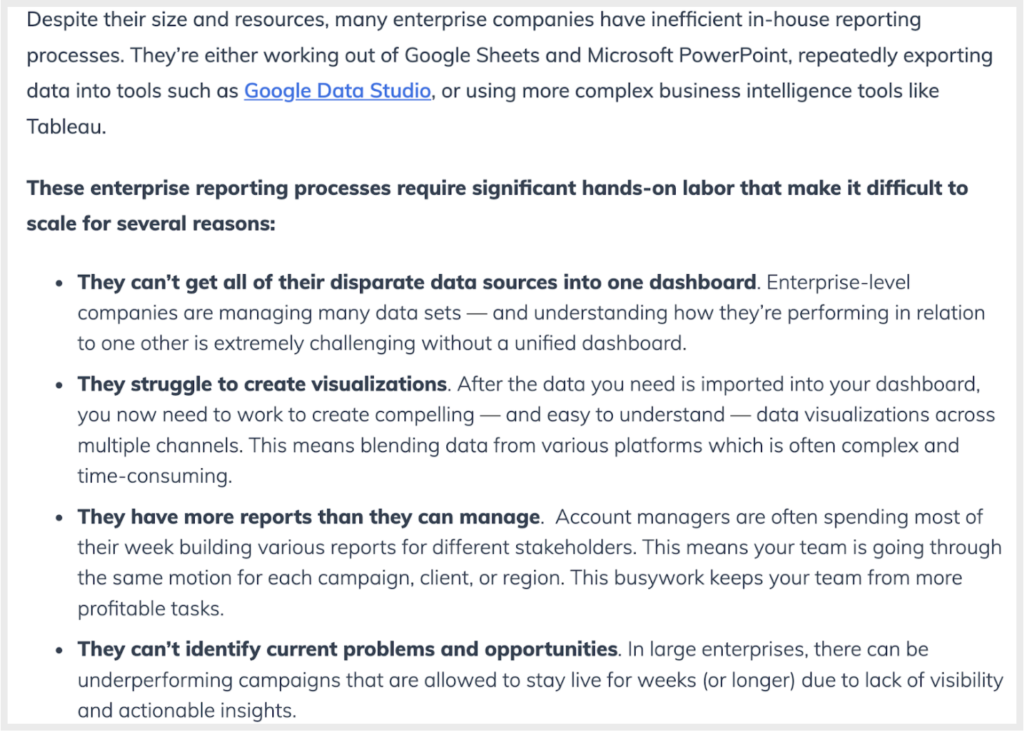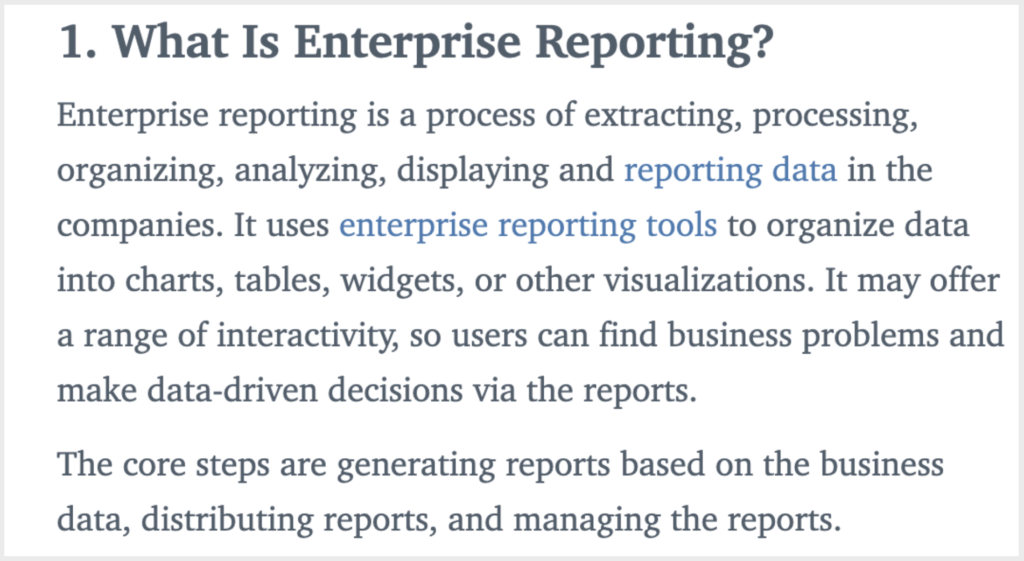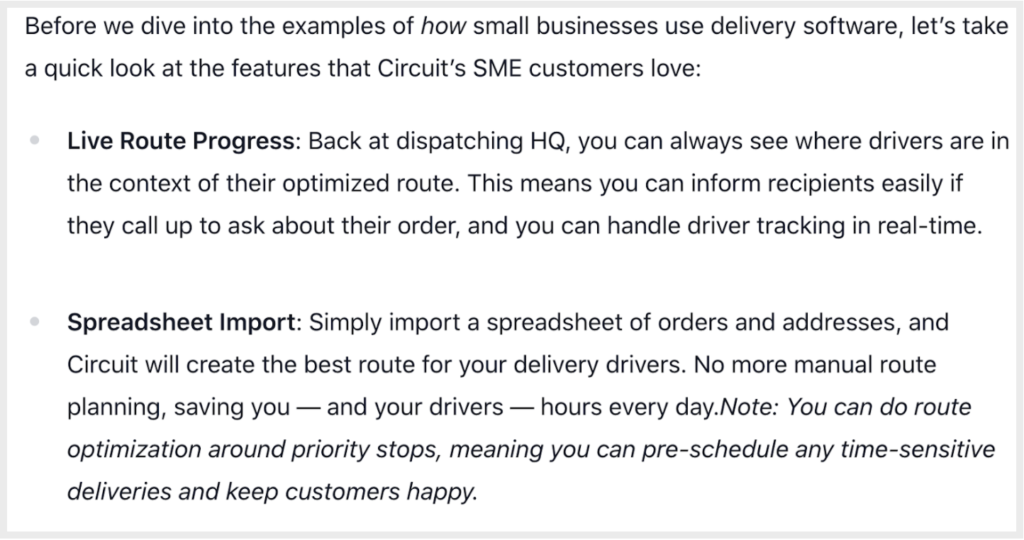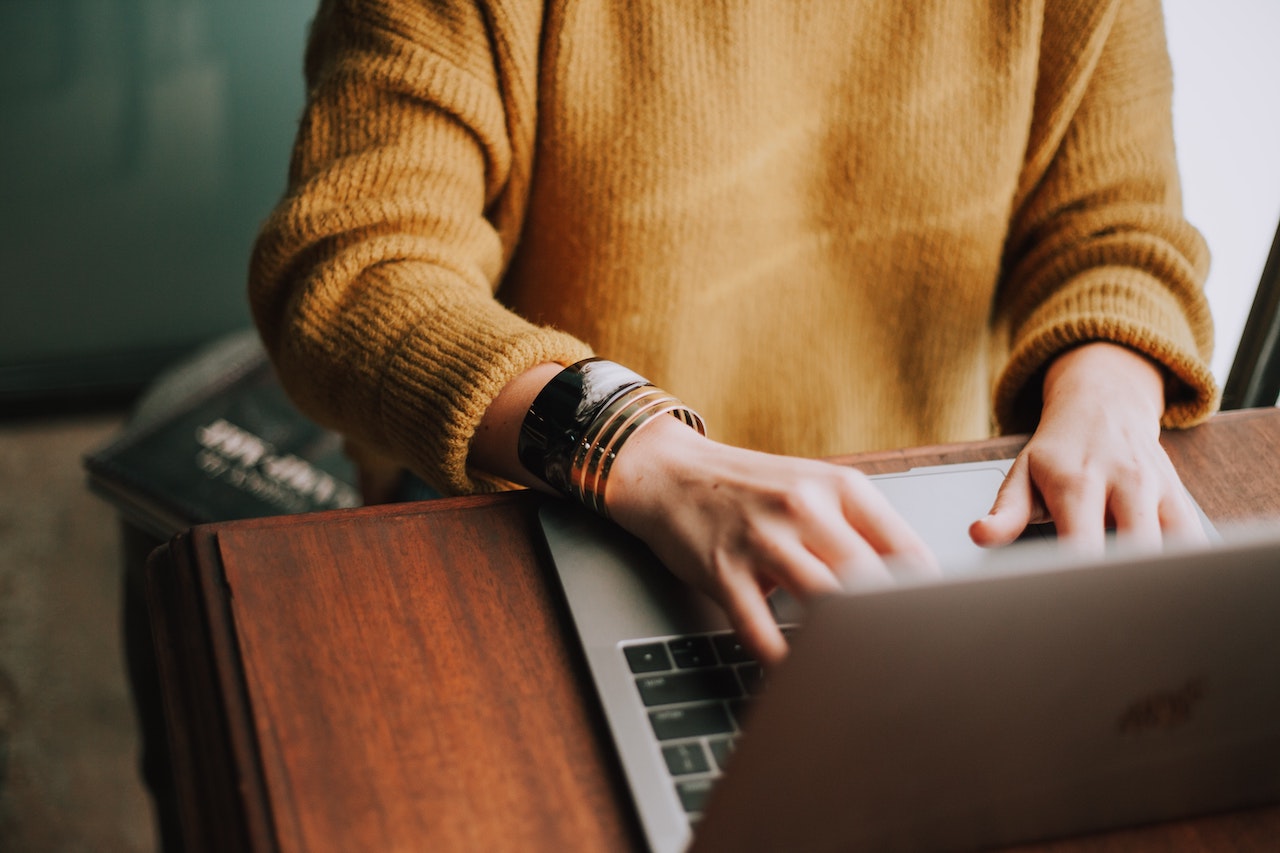In our sales calls with many companies and on Twitter, we’ve heard a common complaint that it’s hard to find high quality blog writers.
I have been trying to hire a content person for months now. 100s of applicants. All suck. People have portfolios with lame ass mediocre articles. Is it that the average writer just sucks – or no one has asked them to be better? People need to be asked for higher standards.
— Pe:p Laja (@peeplaja) June 29, 2018
Yes!
— Pe:p Laja (@peeplaja) June 30, 2018
I also get it now why expensive content agencies are raking it in. Trying to find top 1% quality one by one is super difficult and time consuming

To some extent, this is a fair complaint. One of my jobs at Grow and Convert is to hire writers. So I get the difficulty. I’m regularly living in Peep’s tweet when I sift through mediocre article after mediocre article in the applications.
But here’s what I’ll argue today: There is a much bigger issue with how companies produce blog content than writer quality. Specifically, the vast majority of companies producing blog content have a broken content creation process. And with a broken process, even really good writers will produce bad content, making it seem like they just don’t “get it”.
In fact, as I’ll explain below, the idea of asking writers to “just get it” is unreasonable and the smoke signal for a broken process.
It’s typically said by Founder/CEO types with decades of experience in an industry who expect to find writers that magically happen to have the same level of nuanced understanding of their niche as they do, ready and waiting to write deeply thought provoking articles with minimal editing, all for a few hundred dollars a pop.
Yeah, that’s extremely rare.
We’ve found that most companies use one of three approaches to produce blog content. They:
- Ask writers to self-research a piece
- Hand writers a content brief, then ask them to do the rest
- Have the writer source outside experts for the piece
Fundamentally, all three of those methods have this flaw: They put the onus on the freelance writer to formulate the detailed arguments for the piece and find supporting information for those arguments.
That should not be their responsibility, because they’re not the subject matter expert.
Instead, what we’ve found to work better is to base blog posts on interviews with subject matter experts inside the client’s organization.
In this article, we’ll:
- Dissect the flaws of each of the three methods above (self-research, content brief, outside experts)
- Share our in-house expert approach
- Give examples of real blog posts that illustrate these concepts along the way
But first, we need to clarify what type of content we’re talking about.
We’re Talking About Content Created for the Purpose of Selling a Product Or Service
Before we discuss each of the three approaches above, we need to clarify that we’re talking about content that is meant to attract and convert qualified leads for a business. This content has three characteristics that are important:
- Not journalism or entertainment — First, it’s not consumer facing journalism or entertainment, like say, a New Yorker article, or a HuffPo blog post meant only to be thought provoking, relay some news, or make someone laugh. It’s meant to address very specific questions or the pain points of a very specific person: the company’s target customer.
- Closely related to your product or service — In order to maximize the chances of attracting your ideal customer, your blog post topics need to be as closely related to your product or service as possible (aka “bottom of the funnel”). We’ve discussed this many times on this blog, specifically: How most companies do the opposite and start with top of funnel, then wonder why it doesn’t convert; Our Pain Point SEO approach to fix this; An example of doing content ideation with Pain Point SEO.
- As specific as possible— As we argued in one of our oldest, but still extremely relevant blog posts, your topics need to be as specific as possible because most companies’ best customers have very specific pain points. For example, a cloud security company’s best leads aren’t asking “What is cloud security?” they’re asking “What does it take to become SOC-2 compliant?”. Yet most companies produce more of the former and less of the latter.
Points #2 and #3 specifically (closely related to your product or service, and meant to address specific pain points of your target customer) means people at your company must have deep expertise on these blog topics.
They must have answers to the customers’ questions that are behind these blog topics. Because if they don’t, no one at the company has anything important to say about their customer’s specific, product-related pain points, and either: (1) they shouldn’t be in this business or (2) they are in a commodity business and should be prepared for their content to be as undifferentiated as their product.
You have no business complaining about content quality if you don’t have anything to add to the conversation.
Examples of the blog post topics we are talking about include (all are from our client work):
- Alternatives to standup meetings (Ranks #1 for that term)
- Delivery software for small business (Ranks #1 for that term)
- Post-Concussion Nausea (Ranks #1 for that term)
- Time clock app with gps (Ranks #6 for that term)
- Enterprise reporting tool (Ranks #10 for that term)
*Note rankings can move – these are the ranking positions at the time of writing.
Content Production Approach #1: Give Freelance Writers a Topic and Let Them Self-Research
In our totally unscientific, anecdotal observation after talking to dozens of companies over the years, this is the most popular approach to producing blog content: Companies typically build a list of keywords (or hire an SEO consultant to), hand that list to writers, and expect gold to come out the other end.
This method is flawed.
To understand why, first let’s agree on what a “good” piece is. It typically means a piece that:
- Positions the product in the industry the way the founder/executive would
- Has original or instructive ideas that teach the customer something or answers their question.
Now think of asking a freelance writer to just accomplish both goals on their own at the level that a founder, executive or a long-standing full-time employee at the company would. How is the freelancer expected to know the nuances of how the product is positioned in the market or better than competitors? Also, how would a freelance writer have original solutions to your customer’s product-related pain points?
For many B2B companies, your customer often knows more about the topic you’re writing about than the writer does. The reason being, that your customer is usually an executive or someone that has been in the industry for years, has done deep research on all of the alternatives to your product or service, and is living and breathing these problems every day in their job.
Can’t I Just Outsource to a Writer with Industry Expertise?
This is certainly better than just hiring any writer, but no, that doesn’t solve the problem. We discuss this more below in Approach #3, but in short here’s why:
- Outside experts may have industry expertise, but that doesn’t mean they think of the nuances of your space in the way you do. So if you do this, you’ll get a blog full of their ideas, not yours. The company then doesn’t have a voice of their own. Think of this blog written by someone else in content marketing, would it have the same voice and ideas as us? What would Backlinko be with just some “writer with SEO expertise” instead of Brian Dean?
- Outside industry experts don’t have the deep knowledge of your product that you do. And as we’ve argued in the posts linked to above, the highest converting topics are the ones closely related to your product or service. To position your solution properly in those posts, you need someone from inside the company — an “industry expert” isn’t going to know or care enough to do that.
The Google Research Paper
When writers are given a topic and asked to “go run with it” they end up producing what we call a Google Research Paper. It’s our poking-fun term to refer to the method of Googling around a specific topic to learn about it on the fly, then regurgitating that information back out in an article of your own — like a high school student writing a paper.
The article may be well-written. It may be fun to read, it may have neat images and all the right “SEO stuff”. But this method, almost by definition, produces unoriginal, unimpressive content (or what we like to call Mirage content).

Neat, professional graphic. But does the target audience need to be taught that a video testimonial has a start, middle, and ending?
This is why you see so many posts on the first page of a particular search keyword all making the same points, because they’re all Googling around reading and regurgitating each other’s work.
From a marketing standpoint, the Google Research Paper method has little chance of success, at least when success is measured by the two criteria we mentioned above:
- It positions the product the way the founders or executives would
- It teaches, impresses, or answers questions of the target customers
Examples of Google Research Papers vs. Articles with Unique Insights
First let’s look at a couple of results for the term “Enterprise reporting tool” mentioned above.
Our post for our client Tapclicks.com opens with a specific list of pain points that enterprise companies face with reporting — in particular marketing reporting:
 Note there are almost zero fluff sentences like “reporting is really important to businesses these days” that you’d see in most blog posts introductions. Why? Because the person Googling “enterprise reporting tool” already knows it’s important, that’s why they are Googling to find a tool!
Note there are almost zero fluff sentences like “reporting is really important to businesses these days” that you’d see in most blog posts introductions. Why? Because the person Googling “enterprise reporting tool” already knows it’s important, that’s why they are Googling to find a tool!
(Rant: If someone walks into a car dealership and asks about the Tesla Model S, the sales person doesn’t respond “Electric cars have really been growing in popularity in recent years.” That would be insane. Yet marketers do it in blog posts all the time. I don’t know why.)
Instead, in our piece above, we start by listing incumbent software that most companies are using for reporting today. If the reader is using one of those tools, they will perk their ears up (and it’s likely they are, since we got this information from someone who works with customers every day, as we’ll explain below).
Then, we go right into the pain points. These pain points aren’t just surface level one liners either, they include specifics like who is experiencing pains:
“Account managers are often spending most of their week building various reports for different stakeholders.”
Or specific examples of business consequences, like:
“In large enterprises, there can be underperforming campaigns that are allowed to stay live for weeks (or longer)”
If we wrote this piece without interviewing someone at TapClicks, but just Googling around, would we know a detail like this? Would we think to include it?
In contrast, look at a more typical introduction from another article on Page 1 by a software company called FineReport:

They define what enterprise reporting means, giving the reader insights like the fact that reports often include charts or tables. But so do multiple other results on page 1. All three of these pages start with “What is Enterprise Reporting” and touch on the same few themes:

And “what is enterprise reporting” is just one example. There are more, like this section from another piece of content on page 1 stating that self service reporting means users can create reports themselves:

All of these examples are things any blogger could figure out from just Googling around, and that’s the problem: They’re too basic for the customer.
Think about whether an enterprise customer looking for a reporting tool needs to be told what Enterprise reporting is. Do they not already know that it involves “extracting, processing, organizing, analyzing displaying and reporting data”? Do they not know that it often involves using “charts, tables, widgets, or other visualizations?”
Are they even Googling “enterprise reporting tools” to learn what “enterprise reporting tools” means? Or do they just want a list of tools?
Would reading any of this make the target customer feel that this company really understands their problems?
In contrast, when we wrote our introduction, we knew first hand what the specific challenges of enterprise customers who come to TapClicks are, because our entire piece is based on an interview we did with April, a customer success manager at TapClicks, who works every day with enterprise customers — listening to their specific challenges and helping them solve it with TapClicks.
Here is Cam’s handsome face on the Zoom recording waiting for April to arrive:

That’s first-hand, expert-level knowledge of the readers’ pain points.
So if someone is Googling ‘enterprise reporting tools’ who do you think can better answer their questions: April, who literally does this every day for her job, or a writer who Googled the topic for a couple of hours?
Details in Our Articles That Only In-House Experts Would Know to Include
Here are a few more examples of details that are useful to the customer that it would be very hard or impossible for us to have figured out by ourselves without interviewing someone inside the company.
Later in that enterprise reporting piece, we include this tidbit on the difference between how in-house teams segment marketing reports vs. agencies. It’s really specific and helps the reader understand what they want out of a reporting tool. There’s zero chance we would have known this without interviewing April.

In the small business delivery software piece for Circuit, we have a section highlighting features that Circuit customers like the most in delivery software.
By itself that list requires talking to someone at Circuit, but look at the italicized “Note” in the last sentence. It’s an insanely specific detail assuring customers that even though their app routes stops for you, you can go around the default routing and designate a few as priority stops to do first.
There is zero chance a writer would know this. This was included because someone on their team told us that this “priority stop” issue is a key objection/concern of customers.
Approach #2: The Content Brief
A content brief, which is a document that explains the details behind an article, is a step above just asking the writer to think of everything. It shows that you know you have to give writers information to help them formulate arguments in the piece.
In theory, if a content brief were done really well, it could work.
But from what we’ve seen, most content briefs are just a list of basic information about the piece like SEO keyword it’s targeting, meta title thoughts, and a general blurb on the goal of the piece, like:
- We are targeting this keyword:
- We want the piece to position us as an authority on the topic
- We also want to sell our services a bit, but we want to be genuinely helpful
Some may even include an outline. Taking our enterprise reporting tool example from above, something like:
- Why are enterprise reporting tools important?
- What should you look for in an enterprise reporting tool?
- Here are the leading players in this space
- Here is why our tool is the best
- Call to action
But a basic outline like this is usually pretty obvious. The key between a good piece and not so good piece is what goes inside each of those 5 sections.
Take question 2 of my hypothetical outline. It sounds like a great idea to teach the reader what they should look for in an enterprise reporting tool. But what should you look for? What are the points in that section? The typical content brief asks the writer to figure that out. But they don’t sell enterprise software all day, so they don’t really know the answer. They have to Google and guess.
Wouldn’t a sales person, or product person, or even marketing person at your company who thinks about this all day and maybe has worked there for the past five years be way better qualified to decide what arguments to make on that topic?
Can’t I Just Include Original or Unique Details In The Content Brief?
Yes, you could. But will you? Are you including that level of detail now? Or if you’re the writer, are your clients including those details? Definitely not.
Because it takes time and effort and most managers or founders don’t want to spend that time adding details. They figure, “This is what I’m hiring my writers to do.”
The best details, the ones that make customers stop and think or be wow-ed, do take mental effort to think through. Questions like:
- What do we have to add that’s interesting to this discussion?
- Do we have anything original to say?
- Is it that our software helps the customer do their tasks in a unique way (vs. all of our competitors?)
- Is it that our marketing agency has a different way of doing paid social campaigns? Is our creative better? What is our stance here?
Details like that would be interesting, but that kind of information is almost never in content briefs, because it takes work to provide those arguments. It takes time — occasionally a lot of time — to explain the nuance.
Finally, the best details in articles are ones based on experience — for example, our client Circuit noting how you can make an exception to delivery stops with their app if you have priority deliveries or April for Tap Clicks noting how different marketers use different reports. They only know those details because they’ve heard it first hand from customers.
Writers have no chance of coming up with details like that on their own, and they shouldn’t be asked to.
Approach #3: Writers Source Outside Experts To Chime In
Finally, another common approach to getting subject matter expertise injected into a blog post is interviewing outside experts.
This is also widely done in content marketing and we used to do it all the time in the early stages of our agency work. There are two ways to approach this method:
- Interview a single person for an entire piece
- Interview multiple experts
Here’s an example of approach #1. Continuing our enterprise reporting tools example, the writer would ask on Twitter, ask friends, or ask on HARO for someone who has expertise on enterprise reporting tools. Then, they would set up an interview with whoever said yes (regardless of whether they’re the best person to comment on the matter) and ask questions. In the piece, they’d then credit this person by mentioning that it’s based on an interview with them and link to the interviewee’s website, Twitter, or LinkedIn.
Approach #2 is similar, except writers may just email questions to a few experts and sprinkle their answers as quotes throughout the piece.
This Approach Can Work For Top of the Funnel Content
In theory, either of these approaches make a lot of sense. We think they are certainly way better than the writer doing a Google Research Paper by themselves.
But we think this method is best for top of the funnel pieces like “Ultimate guide” or “How to…” pieces because those usually require covering the fundamentals of a topic.
For example, if you’re writing “The Ultimate Guide to Ecommerce Supply Chain Management”, I’d be curious what various supply chain experts have to say about that.
But if you’re writing that blog post for a supply chain management company’s blog meant to convert likely customers to a demo, that ultimate guide is not going to convert nearly as well as a bottom of funnel piece like: “Best ecommerce supply chain management software”, as we’ve discussed here.
This takes us to the two problems with this approach that have led us to stop doing it almost entirely at our agency:
Problem #1: Outside Experts Don’t Have the Same Opinions as the Company
As we’ve argued, good blog posts need clear opinions on the details of a topic. But those detailed opinions differ between an outside expert and people inside a company. This causes the obvious problem of submitting a piece and having executives at the company say “No we don’t want to say that” or someone telling you “The CEO disagrees with this.”
More importantly though, this is a much bigger deal in bottom of the funnel pieces, because those pieces are really closely related to the company’s product. so the company wants to (and should) control that message. Imagine some outside expert giving their thoughts on what features to look for in enterprise reporting tools. Why would our client, TapClicks, want that on their blog? What if the outside expert’s opinion doesn’t reflect what TapClicks’ platform actually offers?
Which takes us to…
Problem #2: It’s Hard to Tie in the Product
Bottom of the funnel topics are valuable precisely because you can directly mention and pitch your product.
Take another example we mentioned at the beginning, alternative to standup meetings, where our piece for Geekbot ranks #1 as of this writing.

The searcher is looking for alternatives, and Geekbot’s software literally is an alternative to a conventional standup meeting (you can run the meeting asynchronously in Slack instead of in person). So it would be dumb of us not to mention Geekbot heavily in the piece; we do, at length:

But that’s because we relied on interviews with the Geekbot team to inform this piece.
If you click into the piece you can see how the Geekbot section is long and detailed, discussing point by point how Geekbot helps solve issues with standup meetings.
If we had interviewed some outside expert, would they have cared to discuss how and why Geekbot is a good alternative? Likely not. Because why would they? It’s not their company. They don’t think about Geekbot every day. They don’t care to pitch it. Even if they did, would they know how to position it well and discuss in detail how and why it’s better than alternatives? No.
In fact, sometimes with outside experts it can be worse: They spend time trying to pitch whatever it is they’re working on, which usually makes little sense to include in your piece.
Our Solution: Interview Subject Matter Experts Inside the Company
To solve the issues mentioned above, we base almost every piece we write for clients on interviews with someone inside the company. This allows us to:
- Get specific, opinionated, experience-based details
- Tie in the product
Here is our process.
Step 1: When kicking off every piece, we coordinate with our marketing point of contact to find the best person to interview inside the company for that topic.
Step 2: Before the interview, we analyze the SERP and understand:
- What is the search intent? (What questions are they trying to answer? What information are they looking for? What have they likely tried before?)
- What are other people saying on this topic?
- How will the product likely tie into this topic?
Trying to answer those questions will inevitably shed light on holes in our understanding, so we list those out as questions for the subject matter expert.
Step 3: We interview them, ask those questions, record (Zoom), and transcribe (Otter.ai).
For example, here is Cam going over the doc of questions he prepared for the enterprise reporting tools piece we dissected above:

Step 4: We begin our content writing process, which notably includes a questionnaire and outline step before the writer starts the actual draft. We go into detail on how we use our pre-writing questionnaire step in our course, but in short, the point of this questionnaire and outline step is to let the writer and strategist/editor get on the same page on the structure and details of the piece (what arguments or claims are we making, how are we backing them up, etc.) before formal writing has begun. This way, you don’t end up with first drafts (or final drafts) that are way off the mark.
Step 5: Normal draft, edit, and publication steps.
This process has worked extremely well for us and lets us get (1) subject matter expert level details that are experience based, not just theoretical and (2) product tie-ins and positioning into our blog posts, which improves both rankings and conversion rates.
If you’ve done something similar, or have questions, please share in the comments!
Otherwise, you can learn more about our content marketing agency, or reach out about working with us.
We also teach and coach our entire process in our course and content marketing community, including lots of detail and examples not found on this blog.








